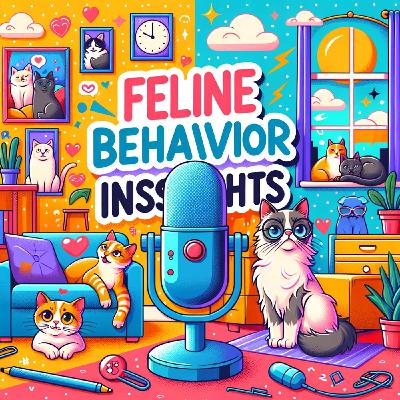Decoding Feline Language: Unraveling the Expressive World of Cats
Update: 2025-11-19
Description
Cats captivate us with their mysterious behaviors, but with a bit of insight, their actions reveal a surprisingly expressive language. According to Tuft & Paw, cats evolved both as predators and prey, shaping instincts that listeners can observe daily in their body language and posture. An open, stretched-out posture signals a relaxed, confident feline, while a tense, hunched posture suggests anxiety or pain. Watch how your cat positions their whiskers: fearful cats tuck whiskers close to their face, while confident cats push them forward. Tail movements are loaded with meaning too — a flicking tail can indicate agitation, while gentle swaying often means contentment.
Best Friends Animal Society explains that relaxed cats show loose, fluid movements, sometimes stretching their feet or slouching in their perch. Their pupils sit at an average size, and slow blinking is a universal sign of comfort. Playful cats might have dilated pupils, a raised tail, and forward-facing ears. The tail is a vital communicator; a twitching or tightly held tail against the body warns of mild stress, while a puffed-up tail signals fear or aggression.
PetMD points out that vocalizations, although not strictly body language, are clear emotional cues. A content cat may purr or knead, while meowing seeks attention or food. When startled, negative vocal cues include hissing or growling, often accompanied by flattened ears or an arched back. Displacement behaviors like excessive grooming or yawning sometimes appear out of context, flagging underlying stress. Sick or painful cats might hunch their body, look dazed, or show their third eyelid.
MedVet Blog highlights the playful nature of cats: batting objects, interactive play, and explorative paws satisfy their hunting instincts. Ears up and forward typically indicate curiosity or attentiveness, while flattened ears may reflect fear or irritation. A tail held high signals happiness, while a tail tucked or twitching points towards insecurity or anticipation.
According to the RSPCA, watch for changes that may signal stress. Excessive grooming, hiding, altering litter box habits, or avoiding people can indicate emotional discomfort. Intense play can quickly overwhelm some cats, shifting into biting or scratching, especially if their body language signals are missed.
Humaneworld.org shares how careful attention to routine, vocalizations, and subtle shifts in posture can help listeners tune into their cat’s emotional wellbeing. A tail moving quickly often shows growing agitation. Ears turned sideways or back, wide pupils, and slinking movements through the house may prompt a nervous cat to seek hiding places.
Cats have social behaviors too. The Merck Veterinary Manual notes that they regulate social interaction with distancing, affiliative behaviors like rubbing and grooming, and antagonistic signals like hissing or swatting. Even a head rub — called bunting — marks territory and brings comfort.
Penn Today highlights that cats recognize their names and form secure bonds with their people. Subtle shifts in daily routines can reveal mood, health, and even affection levels.
Thanks for tuning in to learn more about feline behavior. Be sure to subscribe for more insights. This has been a quiet please production, for more check out quiet please dot ai.
For more http://www.quietplease.ai
Get the best deals https://amzn.to/3ODvOta
This content was created in partnership and with the help of Artificial Intelligence AI
Best Friends Animal Society explains that relaxed cats show loose, fluid movements, sometimes stretching their feet or slouching in their perch. Their pupils sit at an average size, and slow blinking is a universal sign of comfort. Playful cats might have dilated pupils, a raised tail, and forward-facing ears. The tail is a vital communicator; a twitching or tightly held tail against the body warns of mild stress, while a puffed-up tail signals fear or aggression.
PetMD points out that vocalizations, although not strictly body language, are clear emotional cues. A content cat may purr or knead, while meowing seeks attention or food. When startled, negative vocal cues include hissing or growling, often accompanied by flattened ears or an arched back. Displacement behaviors like excessive grooming or yawning sometimes appear out of context, flagging underlying stress. Sick or painful cats might hunch their body, look dazed, or show their third eyelid.
MedVet Blog highlights the playful nature of cats: batting objects, interactive play, and explorative paws satisfy their hunting instincts. Ears up and forward typically indicate curiosity or attentiveness, while flattened ears may reflect fear or irritation. A tail held high signals happiness, while a tail tucked or twitching points towards insecurity or anticipation.
According to the RSPCA, watch for changes that may signal stress. Excessive grooming, hiding, altering litter box habits, or avoiding people can indicate emotional discomfort. Intense play can quickly overwhelm some cats, shifting into biting or scratching, especially if their body language signals are missed.
Humaneworld.org shares how careful attention to routine, vocalizations, and subtle shifts in posture can help listeners tune into their cat’s emotional wellbeing. A tail moving quickly often shows growing agitation. Ears turned sideways or back, wide pupils, and slinking movements through the house may prompt a nervous cat to seek hiding places.
Cats have social behaviors too. The Merck Veterinary Manual notes that they regulate social interaction with distancing, affiliative behaviors like rubbing and grooming, and antagonistic signals like hissing or swatting. Even a head rub — called bunting — marks territory and brings comfort.
Penn Today highlights that cats recognize their names and form secure bonds with their people. Subtle shifts in daily routines can reveal mood, health, and even affection levels.
Thanks for tuning in to learn more about feline behavior. Be sure to subscribe for more insights. This has been a quiet please production, for more check out quiet please dot ai.
For more http://www.quietplease.ai
Get the best deals https://amzn.to/3ODvOta
This content was created in partnership and with the help of Artificial Intelligence AI
Comments
In Channel





